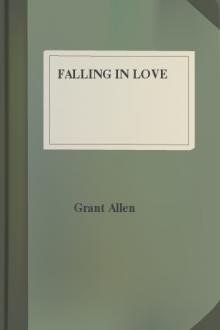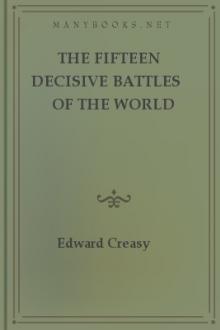Falling in Love by Grant Allen (different e readers .txt) 📕

- Author: Grant Allen
- Performer: -
Book online «Falling in Love by Grant Allen (different e readers .txt) 📕». Author Grant Allen
Example, says the wisdom of our ancestors, is better than precept; so perhaps, if I take a single example to start with, I shall make the principle I wish to illustrate a trifle clearer to the European comprehension. In Australia, when Cook or Van Diemen first visited it, there were no horses, cows, or sheep; no rabbits, weasels, or cats; no indigenous quadrupeds of any sort except the pouched mammals or marsupials, familiarly typified to every one of us by the mamma kangaroo in Regent's Park, who carries the baby kangaroos about with her, neatly deposited in the sac or pouch which nature has provided for them instead of a cradle. To this rough generalisation, to be sure, two special exceptions must needs be made; namely, the noble Australian black-fellow himself, and the dingo or wild dog whose ancestors no doubt came to the country in the same ship with him, as the brown rat came to England with George I. of blessed memory. But of these two solitary representatives of the later and higher Asiatic fauna 'more anon'; for the present we may regard it as approximately true that aboriginal and unsophisticated Australia in the lump was wholly given over, on its first discovery, to kangaroos, phalangers, dasyures, wombats, and other quaint marsupial animals, with names as strange and clumsy as their forms.
Now, who and what are the marsupials as a family, viewed in the dry light of modern science? Well, they are simply one of the very oldest mammalian families, and therefore, I need hardly say, in the levelling and topsy-turvy view of evolutionary biology, the least entitled to consideration or respect from rational observers. For of course in the kingdom of science the last shall be first, and the first last; it is the oldest families that are accounted the worst, while the best families mean always the newest. Now, the earliest mammals to appear on earth were creatures of distinctly marsupial type. As long ago as the time when the red marl of Devonshire and the blue lias of Lyme Regis were laid down on the bed of the muddy sea that once covered the surface of Dorset and the English Channel, a little creature like the kangaroo rats of Southern Australia lived among the plains of what is now the south of England. In the ages succeeding the deposition of the red marl Europe seems to have been broken up into an archipelago of coral reefs and atolls; and the islands of this ancient oolitic ocean were tenanted by numbers of tiny ancestral marsupials, some of which approached in appearance the pouched ant-eaters of Western Australia, while others resembled rather the phalangers and wombats, or turned into excellent imitation carnivores, like our modern friend the Tasmanian devil. Up to the end of the time when the chalk deposits of Surrey, Kent, and Sussex were laid down, indeed, there is no evidence of the existence anywhere in the world of any mammals differing in type from those which now inhabit Australia. In other words, so far as regards mammalian life, the whole of the world had then already reached pretty nearly the same point of evolution that poor Australia still sticks at.
About the beginning of the tertiary period, however, just after the chalk was all deposited, and just before the comparatively modern clays and sandstones of the London basin began to be laid down, an arm of the sea broke up the connection which once subsisted between Australia and the rest of the world, probably by a land bridge, viâ Java, Sumatra, the Malay peninsula, and Asia generally. 'But how do you know,' asks the candid inquirer, 'that such a connection ever existed at all?' Simply thus, most laudable investigator—because there are large land mammals in Australia. Now, large land mammals do not swim across a broad ocean. There are none in New Zealand, none in the Azores, none in Fiji, none in Tahiti, none in Madeira, none in Teneriffe—none, in short, in any oceanic island which never at any time formed part of a great continent. How could there be, indeed? The mammals must necessarily have got there from somewhere; and whenever we find islands like Britain, or Japan, or Newfoundland, or Sicily, possessing large and abundant indigenous quadrupeds, of the same general type as adjacent continents, we see at once that the island must formerly have been a mere peninsula, like Italy or Nova Scotia at the present day. The very fact that Australia incloses a large group of biggish quadrupeds, whose congeners once inhabited Europe and America, suffices in itself to prove beyond question that uninterrupted land communication must once have existed between Australia and those distant continents.
In fact, to this day a belt of very deep sea, known as Wallace's Line, from the great naturalist who first pointed out its far-reaching zoological importance, separates what is called by science 'the Australian province' on the southwest from 'the Indo-Malayan province' to the north and east of it. This belt of deep sea divides off sharply the plants and animals of the Australian type from those of the common Indian and Burmese pattern. South of Wallace's Line we now find several islands, big and small, including New Guinea, Australia, Tasmania, the Moluccas, Celebes, Timor, Amboyna, and Banda. All these lands, whose precise geographical position on the map must of course be readily remembered, in this age of school boards and universal examination, by every pupil-teacher and every Girton girl, are now divided by minor straits of much shallower water; but they all stand on a great submarine bank, and obviously formed at one time parts of the same wide Australian continent, because animals of the Australian type are still found in every one of them. No Indian or Malayan animal, however, of the larger sort (other than birds) is to be discovered anywhere south of Wallace's Line. That narrow belt of deep sea, in short, forms an ocean barrier which has subsisted there without alteration ever since the end of the secondary period. From that time to this, as the evidence shows us, there has never been any direct land communication between Australia and any part of the outer world beyond that narrow line of division.
Some years ago, in fact, a clever hoax took the world by surprise for a moment, under the audacious title of 'Captain Lawson's Adventures in New Guinea.' The gallant captain, or his unknown creator in some London lodging, pretended to have explored the Papuan jungles, and there to have met with marvellous escapes from terrible beasts of the common tropical Asiatic pattern—rhinoceroses, tigers, monkeys, and leopards. Everybody believed the new Munchausen at first, except the zoologists. Those canny folks saw through the wicked hoax on the very first blush of it. If there were rhinoceroses in Papua, they must have got there by an overland route. If there had ever been a land connection between New Guinea and the Malay region, then, since Australian animals range into New Guinea, Malayan animals would have ranged into Australia, and we should find Victoria and New South Wales at the present day peopled by tapirs, orang-outangs, wild boars, deer, elephants, and squirrels, like those which now people Borneo, instead of, or side by side with, the kangaroos, wombats, and other marsupials, which, as we know, actually form the sole indigenous mammalian population of Greater Britain beneath the Southern Cross. Of course, in the end, the mysterious and tremendous Captain Lawson proved to be a myth, an airy nothing upon whom imagination had bestowed a local habitation (in New Guinea) and a name (not to be found in the Army List). Wallace's Line was saved from reproach, and the intrusive rhinoceros was banished without appeal from the soil of Papua.
After the deep belt of open sea was thus established between the bigger Australian continent and the Malayan region, however, the mammals of the great mainlands continued to develop on their own account, in accordance with the strictest Darwinian principles, among the wider plains of their own habitats. The competition there was fiercer and more general; the struggle for life was bloodier and more arduous. Hence, while the old-fashioned marsupials continued to survive and to evolve slowly along their own lines in their own restricted southern world, their collateral descendants in Europe and Asia and America or elsewhere went on progressing into far higher, stronger, and better adapted forms—the great central mammalian fauna. In place of the petty phalangers and pouched ant-eaters of the oolitic period, our tertiary strata in the larger continents show us a rapid and extraordinary development of the mammalian race into monstrous creatures, some of them now quite extinct, and some still holding their own undisturbed in India, Africa, and the American prairies. The palæotherium and the deinoceras, the mastodon and the mammoth, the huge giraffes and antelopes of sunnier times, succeed to the ancestral kangaroos and wombats of the secondary strata. Slowly the horses grow more horse-like, the shadowy camel begins to camelise himself, the buffaloes acquire the rudiments of horns, the deer branch out by tentative steps into still more complicated and more complicated antlers. Side by side with this wonderful outgrowth of the mammalian type, in the first plasticity of its vigorous youth, the older marsupials die away one by one in the geological record before the faces of their more successful competitors; the new carnivores devour them wholesale, the new ruminants eat up their pastures, the new rodents outwit them in the modernised forests. At last the pouched creatures all disappear utterly from all the world, save only Australia, with the solitary exception of a single advanced marsupial family, the familiar opossum of plantation melodies. And the history of the opossum himself is so very singular that it almost deserves to receive the polite attention of a separate paragraph for its own proper elucidation.
For the opossums form the only members of the marsupial class now living outside Australia; and yet, what is at least equally remarkable, none of the opossums are found per contra in Australia itself. They are, in fact, the highest and best product of the old dying marsupial stock, specially evolved in the great continents through the fierce competition of the higher mammals then being developed on every side of them. Therefore, being later in point of time than the separation, they could no more get over to Australia than the elephants and tigers and rhinoceroses could. They are the last bid for life of the marsupial race in its hopeless struggle against its more developed mammalian cousins. In Europe and Asia the opossums lived on lustily, in spite of competition, during the whole of the Eocene period, side by side with hog-like creatures not yet perfectly piggish, with nondescript animals, half horse half tapir, and with hornless forms of deer and antelopes, unprovided, so far, with the first rudiment of budding antlers. But in the succeeding age they seem to disappear from the eastern continent, though in the western, thanks to their hand-like feet, opposable thumb, and tree-haunting life, they still drag out a precarious existence in many forms from Virginia to Chili, and from Brazil to California. It is worth while to notice, too, that whereas the kangaroos and other Australian marsupials are proverbially the very stupidest of mammals, the opossums, on the contrary, are well known to those accurate observers of animal psychology, the plantation negroes, to be the very cleverest, cunningest, and slyest of American quadrupeds. In the





Comments (0)